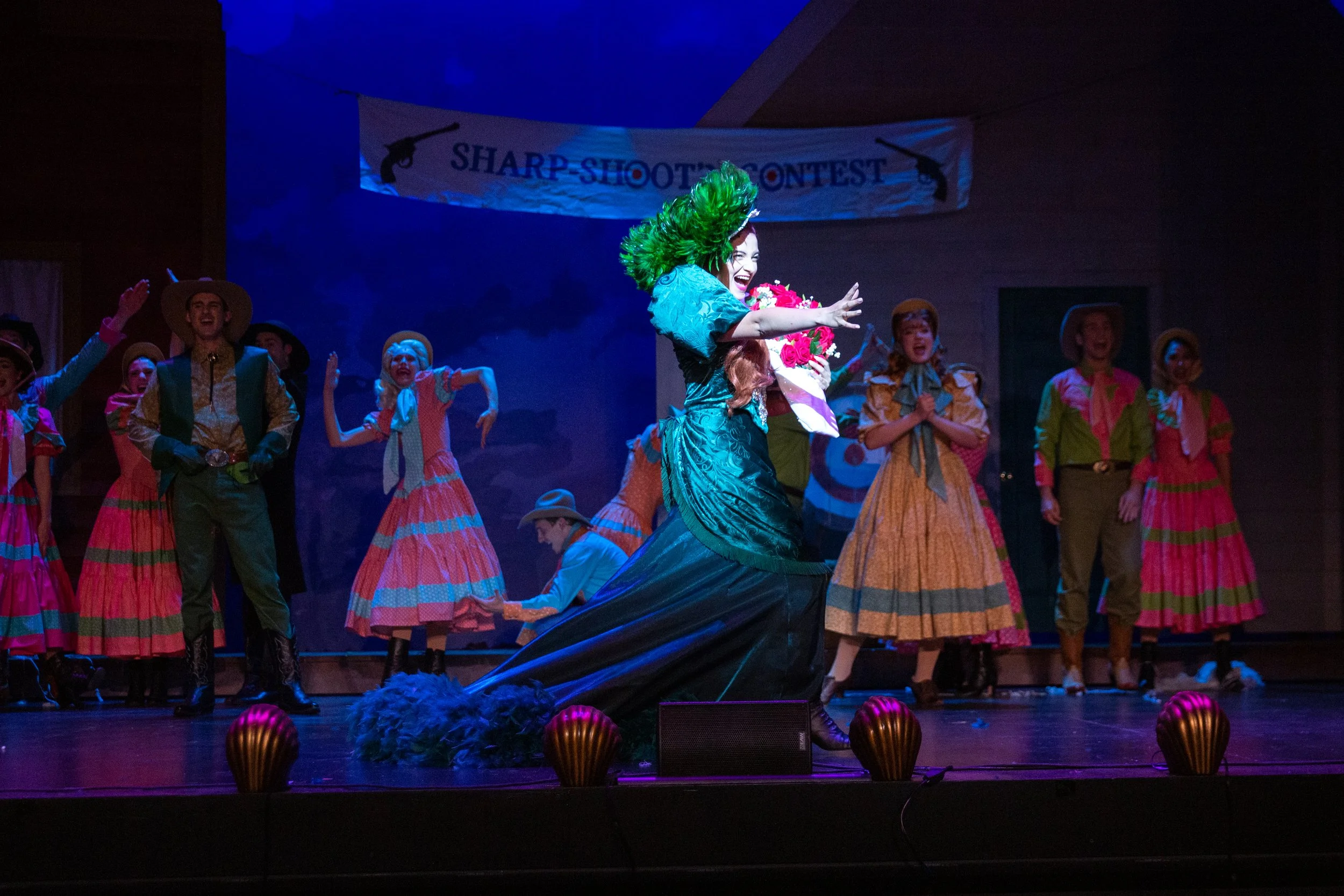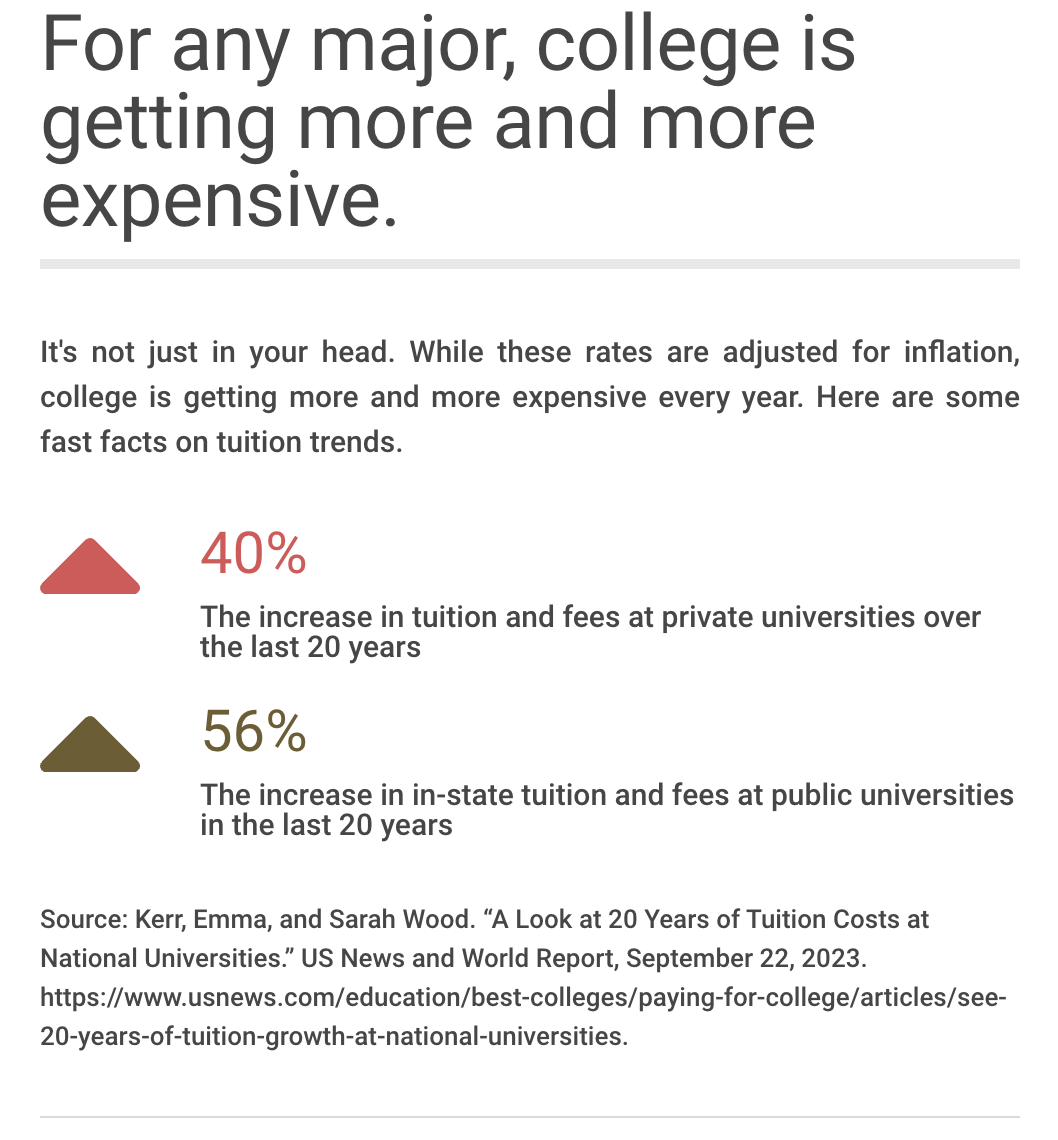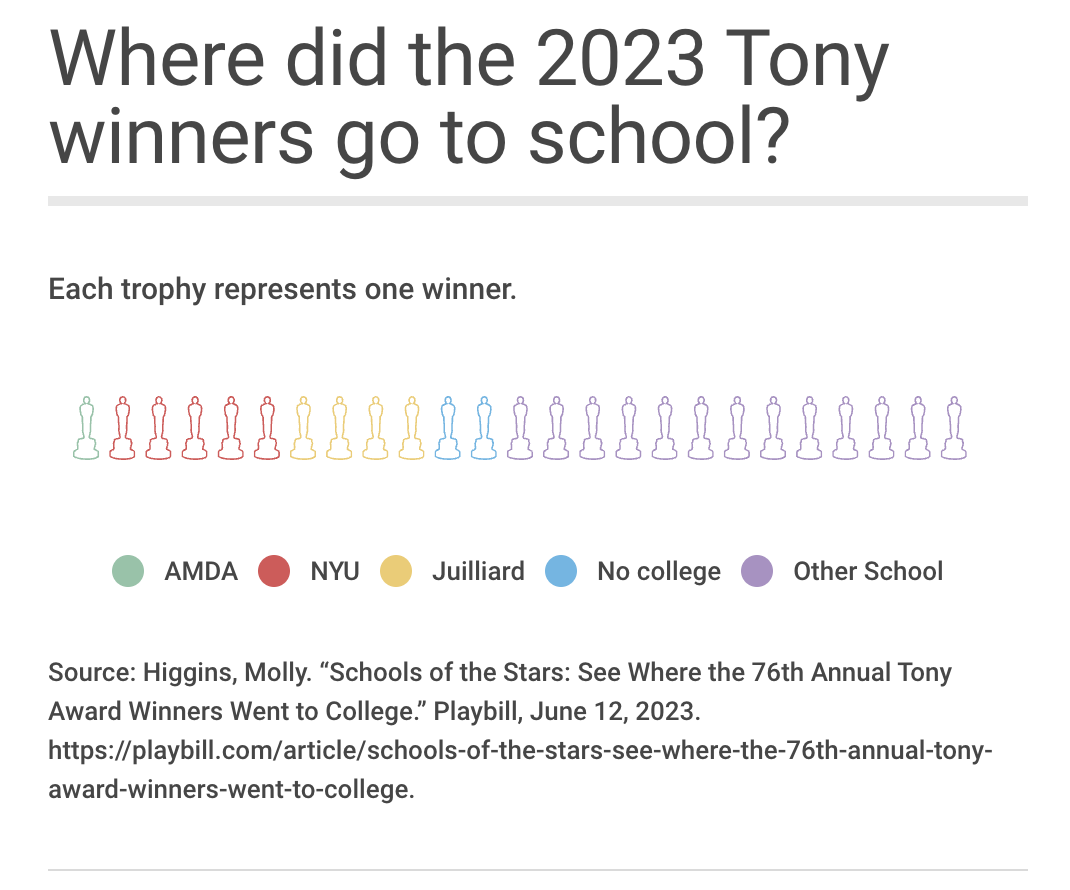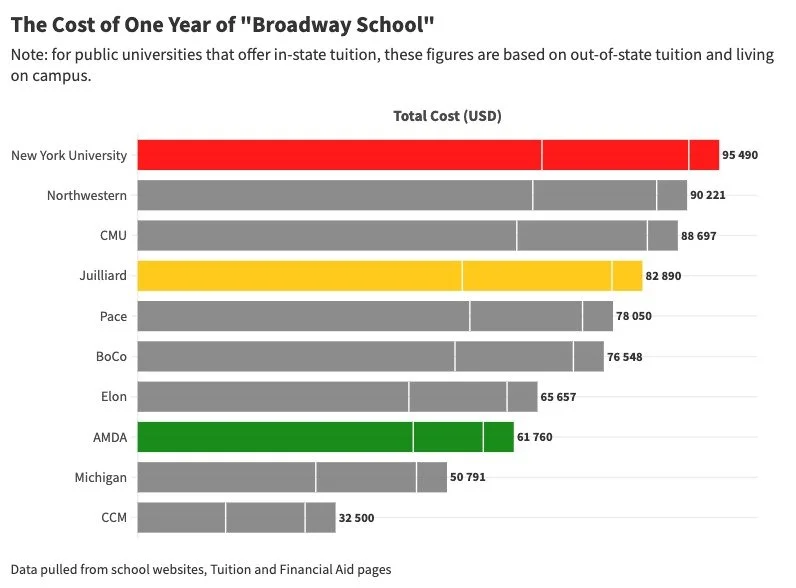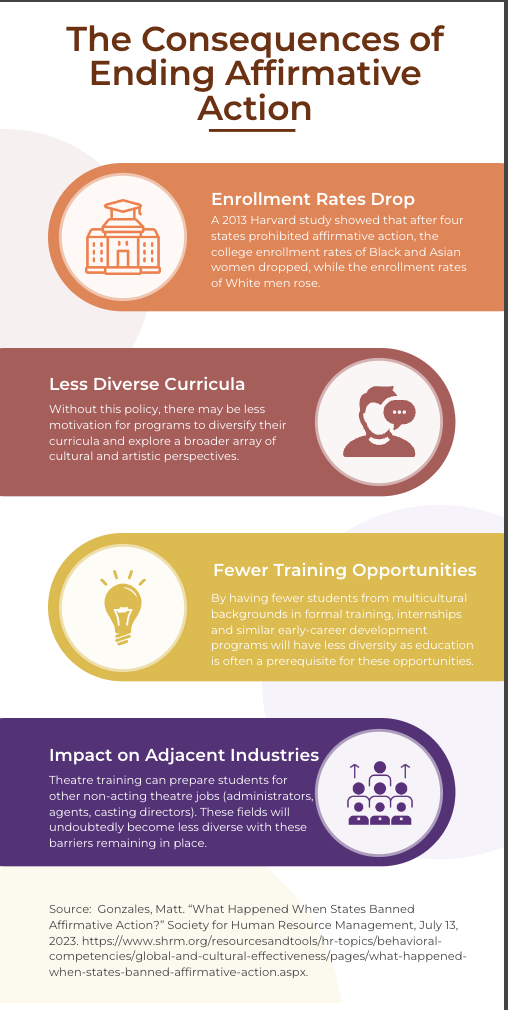introduction
Every year, thousands of high school seniors across the United States (and a privileged few from countries across the globe) participate in what laymen could only describe as the closest possible experience to a human cattle call: the musical theatre college audition process. From campus visits to testing to prescreens and the final audition, the process can cost thousands of dollars for an auditioner and their family, even without additional support like coaching or a summer intensive program. While, of course, institutional and governmental financial aid is available, these are not resources that are available to all students during their process and education.
Playbill, a theatre magazine perhaps most famous for its iconic programs that are featured in many Instagram stories, releases an annual report of the Top 10 Colleges and Universities Represented on Broadway from the previous year. The messaging of the best theatre schools is reinforced each year around June when Playbill releases another article on where that year’s Tony Award-winning actors, directors, and designers went to college. Many high school students, hoping to make it in the business, start their college search here - but what is the true cost of a musical theatre degree from one of these institutions?
What role is this process playing in enforcing systemic bias?
For this analysis, I've taken Playbill's Top 10 List from the most recent season, swapped out Yale as it is a graduate program for Elon University, one of the honorable mention schools, and taken the schools through some evaluation like an applicant would. How much do they cost? Are their alumni winning Tony Awards? To fully understand the opportunities available, I will analyze the costs of the current (as of November 2023) top 10 most represented schools on Broadway, the competition surrounding the process, and the possible consequences of the Supreme Court’s ruling to end affirmative action.
Unmasking the Problem from the Inside
I went through the college audition process myself in 2017-2018, and I remember the process so vividly. My theatre education shaped the arts manager I am now, and a career in performance is not the only successful outcome of a BFA. I'm passionate about increasing access to the arts; a big part of that access is opening pathways to education. Without the resources I was fortunate enough to have, I would not be in this position.
Image: Production of Curtains, photo of Ashley Offman
Image Source: Ashley Offman, photographed by John Altdorfer
what are the costs?
Traditional college applications typically have two fees associated with them: an application fee for the institution and a fee to take a standardized test, such as the ACT or SAT. However, there is no true standard with the college audition process. Some of the leading theatre schools will charge double, or even triple, the cost of a traditional application to thousands of prospective students as illustrated in Figure 2.
Image: Figure 1 (For any major, college is getting more and more expensive)
Image Source: Created by Ashley Offman
Image: Figure 2 (The cost of applying to theatre programs is a bad omen)
Image Source: Created by Ashley Offman
Besides the school's application fee, many schools charge an audition or prescreening fee. Many students choose to audition in person, which incurs additional fees for travel and lodging. Specialized clothing/footwear is required for dance auditions, and some students choose to hire a coach to help them with their material. A common way that students and their families attempt to mitigate these costs is by participating in Unified Auditions, where several schools are in one major city. While auditions like this can help reduce travel costs as a student can stay in one city and knock out several auditions over a few days, they miss out on the experience of seeing the college's campus or surrounding area, meaning they may want to pay for a visit in the future should they be accepted.
Image: Figure 3 (Where did the 2023 Tony winners go to school?)
Image Source: Created by Ashley Offman
We can see from the above figure that 3 of the top 10 schools in this study were represented by Tony winners this season. By comparing programs by cost for one year of tuition and applicable fees, such as on-campus housing and a meal plan, as shown in Figure 4, it becomes clear that almost all of the top programs are private schools. From left to right, the segments of the cost bar represent tuition, living expenses, and supplies directly related to theatre coursework.
Image: Figure 4 (The Cost of One Year of “Broadway School”)
Image Source: Created by Ashley Offman
The 2 public universities’ (Michigan and CCM) tuition and fees were calculated for an out-of-state student. The average cost of these 10 schools was $69,210.10 per year. If a Tony Award-winning actor went to NYU, you could assume that their Tony Award could be worth up to $381,960. Students may be paying for this success for decades, however, as the average federal student loan debt is $37,338 (Hanson 2023).
COMPETITION IS FIERCE
In 2018, Carnegie Mellon University's musical theatre program had a 0.5% acceptance rate. That's more competitive than Juilliard (7.4%), which is widely regarded as the most selective performance program in the world.
Musical theatre programs are known to be highly selective and competitive- but this selectivity appears to pay off. Of 25 Tony Award winners this season (not including producers), 40% were from one of the top 10 most represented schools, according to Playbill.
In academia, the Ivy League is considered to be the training ground for the most elite students in the world. Something that is not made a public fact in musical theatre programs is while the university itself may have a certain acceptance rate, the acceptance rate for its theatre program is far lower. The only programs of this nature that publish their acceptance rates are schools that exclusively offer performance (or performance-adjacent) degrees such as Juilliard or the Curtis Institute. Perhaps these are not made public as seeing an acceptance rate such as 0.5% could deter many applicants. While Ivy League schools may subject their applicants to countless interviews or supplemental materials to get a holistic view of their pool, theatre programs are pinpoint the audition as a primary driver to a student’s acceptance. Even if a student meets the academic application criteria for a school and is eligible for admission and large merit scholarships, it is ultimately the artistic portion of their application that overrides any academic merit. While students in the position of academically accepted but artistically denied may explore the option of attending a school on an alternate course of study, the feelings of rejection and defeat that arise from this decision steer students away from this path.
consequences of Ending Affirmative Action
““It is imperative that our artistic institutions actively recruit, mentor, support and resource black and brown artists so that we may all experience a vibrant and visionary future on the other side of this period of ideological warfare.”
”
Broadway is continuing to center white stories, and without access to high-quality theatre education, students will lose the opportunity to hone their craft and learn the skills to tell stories that are more representative of the global majority. All students benefit from a diverse learning environment; research published in The Sociological Quarterly suggests that “the mere inclusion of different perspectives, and especially divergent ones, in any course or discussion leads to the kind of learning outcomes (e.g., critical thinking, perspective-taking) that educators, regardless of field, are interested in.”
Affirmative action policies led schools to adopt more inclusive and diverse curricula that reflect a wide range of theatrical traditions, styles, and voices. Yet, the federal government banned affirmative action in June 2023, leaving universities unable to consider a student's race in their admissions decision. This makes efforts like race-conscious recruiting impossible.
Image: Figure 5 (The Consequences of Ending Affirmative Action)
Image Source: Created by Ashley Offman
Musical theatre is a uniquely American art form; therefore, one may argue that as a means of cultural representation, it is valuable for the industry to be representative of the country’s population. According to data from Actor's Equity and the U.S. Census, the industry is becoming more homogenized than the population of the United States. The US Census found that in 2020, 61.6% of the population was White while the Actor’s Equity Association (the union for professional actors) reported that in 2021, 63.95% of their employed actors were White. Additionally, nearly 63% of dramatic arts degrees awarded in the U.S. are earned by White students (Cliburn 2022). These figures are only bound to become more inequitable with policies that discourage diversity in place.
Image: Figure 6 (Do Broadway Stages Really Represent America?)
Image Source: Created by Ashley Offman
As universities and colleges are often the pipeline to professional stages, concert halls, and movie screens, the potential for creating truly representative storytelling is curtailed (perhaps that was the point). Further down the line, some students who go through musical theatre programs choose to teach once their time on stage has ended, but the saturation of white theatre department heads will only continue to rise if pathways are not created for non-white students to gain the experience they can pay forward to future generations of students. The worst case would be that shows as diverse as Hamilton, which actively practices race-conscious casting, could become a thing of the past.
solutions
While this article cannot solve the recruitment problem caused by the Supreme Court, I would like to make recommendations for how individuals who are passionate about increasing access to a college education in the performing arts can support the future. Individuals can donate to organizations like The Fund For College Auditions (TFCA). According to its mission statement, TFCA is a New York-based nonprofit that “offers financial support and college guidance to acting and musical theatre students with limited resources who want to audition for post-high school training programs.” If you attended a college with a competitive performing arts program, support their creating funds or endowments to create free pathways for auditions and increased scholarships. If you’ve attended a performance at one of these schools, return to the theatre to affirm the importance of the art form to the surrounding community, or consider volunteering in a community initiative to bring people into our sacred playing spaces, maybe for the first time ever. Those audience members may become the future of Broadway. By lowering the hurdles of cost and access, those who are historically underrepresented will gain more equal footing in the process.
Read more about my process (and get the sources for my tuition data) here.
-
“2024 Hardest Colleges to Get Into.” Niche. Accessed October 10, 2023. https://www.niche.com/colleges/search/hardest-to-get-in/.
“Admissions Statistics.” Harvard College. Accessed October 10, 2023. https://college.harvard.edu/admissions/admissions-statistics.
Bhaskara, Vinay. “What the End of Affirmative Action Means for Colleges and Universities.” Forbes, June 30, 2023. https://www.forbes.com/sites/vinaybhaskara/2023/06/29/what-the-end-of-affirmative-action-means-for-colleges-and-universities/?sh=c28897417490.
Cliburn, Erik. “Theater Programs Work to Reduce Major Representation Gaps in the Industry.” INSIGHT Into Diversity, May 17, 2022. https://www.insightintodiversity.com/theater-programs-work-to-reduce-major-representation-gaps-in-the-industry/.
Conley, Danee, Russell Lehrer, David Levy, Rachel Goldfarb, and Sidney Wegener. “Hiring Bias and Wage Gaps in 2021.” Actor’s Equity Association, 2023. https://cdn.actorsequity.org/docs/HiringBiasWageGaps2021.pdf.
Evanicki, Tim. “The (Less than) One Percent.” Dramatics Magazine Online, January 7, 2019. https://dramatics.org/the-less-than-one-percent/.
Gonzales, Matt. “What Happened When States Banned Affirmative Action?” Society for Human Resource Management, July 13, 2023. https://www.shrm.org/resourcesandtools/hr-topics/behavioral-competencies/global-and-cultural-effectiveness/pages/what-happened-when-states-banned-affirmative-action.aspx.
Hanson, Melanie. “Average Student Loan Debt.” EducationData.org, May 22, 2023. https://educationdata.org/average-student-loan-debt
Higgins, Molly. “Schools of the Stars: See Where the 76th Annual Tony Award Winners Went to College.” Playbill, June 12, 2023. https://playbill.com/article/schools-of-the-stars-see-where-the-76th-annual-tony-award-winners-went-to-college.
Janiak, Lily. “Bay Area Artists on Affirmative Action: ‘When I Tell My Story, Race Matters.’” The San Francisco Chronicle, July 5, 2023. https://www.sfchronicle.com/entertainment/article/bay-area-artists-affirmative-action-race-matters-18178112.php.
Jones, Nicholas, Rachel Marks, Roberto Ramirez, and Merarys Rios-Vargas. “2020 Census Illuminates Racial and Ethnic Composition of the Country.” Census.gov, June 10, 2022. https://www.census.gov/library/stories/2021/08/improved-race-ethnicity-measures-reveal-united-states-population-much-more-multiracial.html. Originally published August 12, 2021.
Kerr, Emma, and Sarah Wood. “A Look at 20 Years of Tuition Costs at National Universities.” US News and World Report, September 22, 2023. https://www.usnews.com/education/best-colleges/paying-for-college/articles/see-20-years-of-tuition-growth-at-national-universities.
Pitt, Richard N. and Josh Packard (2012), ACTIVATING DIVERSITY: The Impact of Student Race on Contributions to Course Discussions. The Sociological Quarterly, 53: 295-320. https://doi.org/10.1111/j.1533-8525.2012.01235.x
“THE VISIBILITY REPORT: RACIAL REPRESENTATION ON NEW YORK CITY STAGES- 2018-2019.” The Asian American Performers Action Coalition, 2021. http://www.aapacnyc.org/2018-2019.html.
Zamansky, Natan. “Big 10 2023: The 10 Most Represented Colleges on Broadway in the 2022-2023 Season.” Playbill, September 7, 2023. https://www.playbill.com/article/big-10-2023-the-10-most-represented-colleges-on-broadway-in-the-2022-2023-season.


